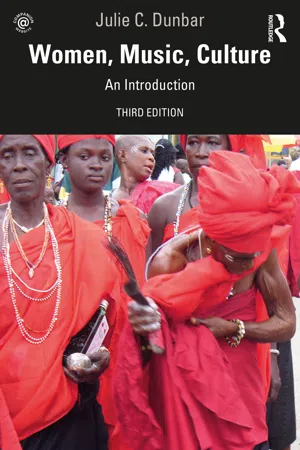
- 400 pages
- English
- ePUB (mobile friendly)
- Available on iOS & Android
About this book
Women, Music, Culture: An Introduction, Third Edition is the first undergraduate textbook on the history and contributions of women in a variety of musical genres and professions, ideal for students in Music and Gender Studies courses. A compelling narrative, accompanied by 112 guided listening experiences, brings the world of women in music to life. The author employs a wide array of pedagogical aides, including a running glossary and a comprehensive companion website with links to Spotify playlists and supplementary videos for each chapter. The musical work of women throughout history—including that of composers, performers, conductors, technicians, and music industry personnel—is presented using both art music and popular music examples.
New to this edition:
- An expansion from 57 to 112 listening examples conveniently available on Spotify.
- Additional focus on intersectionality in art and popular music.
- A new segment on Music and #MeToo and increased coverage of protest music.
- Additional coverage of global music.
- Substantial updates in popular music.
- Updated companion website materials designed to engage all learners. Visit the author's website at www.womenmusicculture.com
Frequently asked questions
- Essential is ideal for learners and professionals who enjoy exploring a wide range of subjects. Access the Essential Library with 800,000+ trusted titles and best-sellers across business, personal growth, and the humanities. Includes unlimited reading time and Standard Read Aloud voice.
- Complete: Perfect for advanced learners and researchers needing full, unrestricted access. Unlock 1.4M+ books across hundreds of subjects, including academic and specialized titles. The Complete Plan also includes advanced features like Premium Read Aloud and Research Assistant.
Please note we cannot support devices running on iOS 13 and Android 7 or earlier. Learn more about using the app.
Information
PART I
Telling Musical Stories
INTRODUCTION TO PART I
TELLING MUSICAL STORIES
Missing Voices in the Documentation of Musical Traditions
CHAPTER 1
Reflections on “Deep Listening”
A SOCIOCULTURAL MODEL FOR STUDYING MUSIC

GUIDED LISTENING EXPERIENCE 1.1: “FREEDOM” FROM LEMONADE
Listen and Analyze
Table of contents
- Cover
- Half Title
- Title Page
- Copyright Page
- Dedication Page
- Contents
- Guided Listening Experiences Summary
- Focus Topics Summary
- Preface
- Acknowledgments
- Part I Telling Musical Stories: Missing Voices in the Documentation of Musical Traditions
- Part II Restricted Domains: Gender Spheres in Art Music
- Part III Visual Images in an Aural World
- Part IV A Time of Change: The Impact of Education on Women’s Art Music Activity
- Part V No Longer “One of the Boys”
- Glossary
- Index